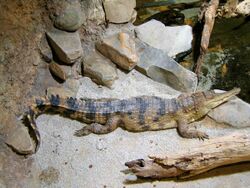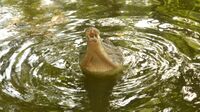Biology:Slender-snouted crocodile
| Slender-snouted crocodile Temporal range: Pliocene – Recent
| |
|---|---|

| |
| Scientific classification | |
| Kingdom: | |
| Phylum: | |
| Class: | |
| Order: | |
| Family: | |
| Subfamily: | |
| Genus: | Mecistops Gray, 1844
|
| Species: | M. cataphractus
|
| Binomial name | |
| Mecistops cataphractus (Cuvier, 1825)
| |

| |
| Range map | |
| Synonyms | |
|
Crocodylus cataphractus Cuvier, 1825 | |
The slender-snouted crocodile (Mecistops cataphractus) is a critically endangered species of crocodile from Africa. Traditionally placed in Crocodylus, recent studies in DNA and morphology have shown that it belongs in its own genus, Mecistops,[2][3][4][5] and that it should be split into two species.[6]
Description
Slender-snouted crocodiles are native to freshwater habitats in central and western Africa. They prefer highly vegetated bodies of water in order to hide from prey and potential predators. They are medium-sized crocodiles, typically slightly smaller than the Nile crocodile, but are larger than several other species of crocodilians. Adults are typically about 2.5 m (8.2 ft) long, but have been known to reach 4.2 m (14 ft).[7][8] They weigh between 125 and 325 kg (276 and 717 lb).[9][10] Males are significantly larger than females. They have a slender snout used for catching prey, hence their name. They are an incredibly shy species of crocodile.
Behaviour

The diet of the slender-snouted crocodile consists mainly of fish, amphibians and crustaceans. Typically, they can be found basking on land. Adults occasionally take smaller mammals, aquatic snakes, turtles and birds.[1] This species is not typically found in groups, except during the onset of the breeding season. The female constructs a mound nest consisting mainly of plant matter. The nests are usually 50 to 60 cm high and 1 to 2 m in diameter. Nests are sited on the banks of rivers, and construction generally begins at the onset of the wet season, although breeding is asynchronous even within members of one population. It has a similar, but generally shorter nesting season than that of the sympatric dwarf crocodile, which may nest further from the riverine habitat frequented by M. cataphractus. The breeding season begins in January and February and lasts until July.
The slender-snouted crocodile lays an average of 16 (minimum 13, maximum 27) very large eggs (relative to body size) about a week after completion of the mound nest. The nests are constructed out of decaying vegetation.[11] The incubation period is long compared with most other crocodilian species, sometimes lasting over 110 days. The average incubation for female offspring is 90 to 100 days and for males is usually 85 to 86 days. The female remains close to the nest, but does not defend it with the same vigor as some other species of crocodilians. Once the eggs begin to hatch, and the juveniles emit their characteristic chirping, she will break open the nest and assist in the hatching process. Hatchlings then disperse across the flooded forest floor. Although losses from predators do occur (e.g. by soft-shelled turtles), they apparently are minimal, possibly accounting for the small number of relatively large eggs laid, and the long incubation period. The sex of the eggs are determined by temperature. Females are produced between 28 C and 31 C. Males are produced between 31 C and 33 C. The maximum temperature that the eggs are able to withstand is 34 C and produce females.[12] Sex is determined between day 14 and 21. The mothers will help the offspring hatch if they can not do so themselves. Hatchlings are precocious and mimic a smaller version of the parents. They also have very sharp teeth for protection. It is one of four species of crocodile in Africa, the other three being the Nile, West African and dwarf crocodiles.
This species has good hearing, eyesight, and smell. Throughout the body of crocodiles, sensory pits are present, which nerve terminals are inside. There are two types of these sensory pits, integumentary sense organs that cover the body and papillae that cover the head, primarily around the snout. When underwater, crocodile have a “third eyelid” called a nictitating membrane. This membrane is present in many other reptiles, but is unique in crocodiles because it is semi-transparent and acts as goggles in improve eyesight when hunting and prevents eye damage. Crocodiles are able to make certain acoustic sounds, especially juveniles. Hatchling crocodiles are able to indicate when they will hatch by making a vocalization that can be heard by the mother. Crocodiles can make coughing, hissing, and bellowing vocalizations usually when feeling threatened.
Status
This species is relatively poorly known with few studies of the wild populations. Consequently, it was rated as Data Deficient by the IUCN in 1996. Following a review in 2014, it was moved to Critically Endangered.[1] It appears to have been entirely extirpated from several countries where formerly present and declined elsewhere.[1] Although threatened overall, relatively robust populations remain in parts of Central Africa, especially Gabon.[6] In contrast, it is extremely rare in West Africa where on the verge of disappearing.[6] Threats include hunting (skin and bushmeat), habitat loss, overfishing (it mainly feeds on fish) and general disturbance (it is very shy). There is considerable uncertainty about the size of the wild population, but it is estimated that between 1,000 and 20,000 remain.[1] Slender-snouted crocodiles are kept and bred at a number of zoos in Europe and North America, and the Ivory Coast has started a captive breeding program.[1] A study in 2015 that included 24 captive slender-snouted crocodiles in six US zoos (more than 50% of the slender-snouted crocodiles in AZA zoos) found that all were of West African origin.[13]
Taxonomy
Traditionally placed in Crocodylus, studies in DNA and morphology have shown that it is basal to this genus, leading to its move to its own genus Mecistops.[2][3][4][5]
Genetic and morphological evidence published in 2014 suggests that the slender-snouted crocodile in fact comprises two separate species: The West African Mecistops cataphractus and the as yet unnamed Central African population. The two are separated by the Cameroon Volcanic Line and split from each other about 6.5–7.5 million years ago.[6]
References
- ↑ 1.0 1.1 1.2 1.3 1.4 1.5 Template:IUCN2015.1
- ↑ 2.0 2.1 McAliley, Willis, Ray, White, Brochu & Densmore (2006). Are crocodiles really monophyletic?—Evidence for subdivisions from sequence and morphological data. Molecular Phylogenetics and Evolution 39: 16–32.
- ↑ 3.0 3.1 Brochu, C. A.; Njau, J.; Blumenschine, R. J.; Densmore, L. D. (2010). "A New Horned Crocodile from the Plio-Pleistocene Hominid Sites at Olduvai Gorge, Tanzania". PLoS ONE 5 (2): e9333. doi:10.1371/journal.pone.0009333. PMID 20195356.
- ↑ 4.0 4.1 Robert W. Meredith; Evon R. Hekkala; George Amato; John Gatesy (2011). "A phylogenetic hypothesis for Crocodylus (Crocodylia) based on mitochondrial DNA: Evidence for a trans-Atlantic voyage from Africa to the New World". Molecular Phylogenetics and Evolution 60: 183–191. doi:10.1016/j.ympev.2011.03.026. PMID 21459152.
- ↑ 5.0 5.1 Brochu, C. A.; Storrs, G. W. (2012). "A giant crocodile from the Plio-Pleistocene of Kenya, the phylogenetic relationships of Neogene African crocodylines, and the antiquity of Crocodylus in Africa". Journal of Vertebrate Paleontology 32 (3): 587. doi:10.1080/02724634.2012.652324.
- ↑ 6.0 6.1 6.2 6.3 Shirley; Vliet; Carr; and Austin (2014). "Rigorous approaches to species delimitation have significant implications for African crocodilian systematics and conservation". Proceedings of the Royal Society B 281 (1776). doi:10.1098/rspb.2013.2483.
- ↑ WAZA: Crocodylus cataphractus. Retrieved 18 January 2016.
- ↑ Crocodilians, Natural History & Conservation: Crocodylus/Mecistops cataphractus. Retrieved 18 January 2016.
- ↑ African Slender-Snouted Crocodile | The Maryland Zoo in Baltimore. Marylandzoo.org. Retrieved on 2014-05-07.
- ↑ Slender-Snouted Crocodile | San Diego Zoo Animals. Sandiegozoo.org. Retrieved on 2014-05-07.
- ↑ Groombridge 1982 | title=The IUCN Amphibia - Reptilia Red Data Book
- ↑ Bradford 2017 |title= Health Survey Including Selected Blood Parameters in the African Slender Snouted Crocodile (Mecistops cataphractus) at the Abidjan Zoo in Cote d-'Ivoire
- ↑ Shirley; Villanova; Vliet; and Austin (2015). "Genetic barcoding facilitates captive and wild management of three cryptic African crocodile species complexes". Animal Conservation 18 (4): 322–330. doi:10.1111/acv.12176.
Wikidata ☰ Q268501 entry


